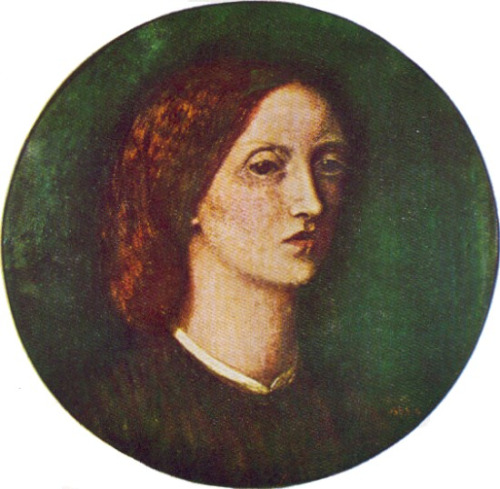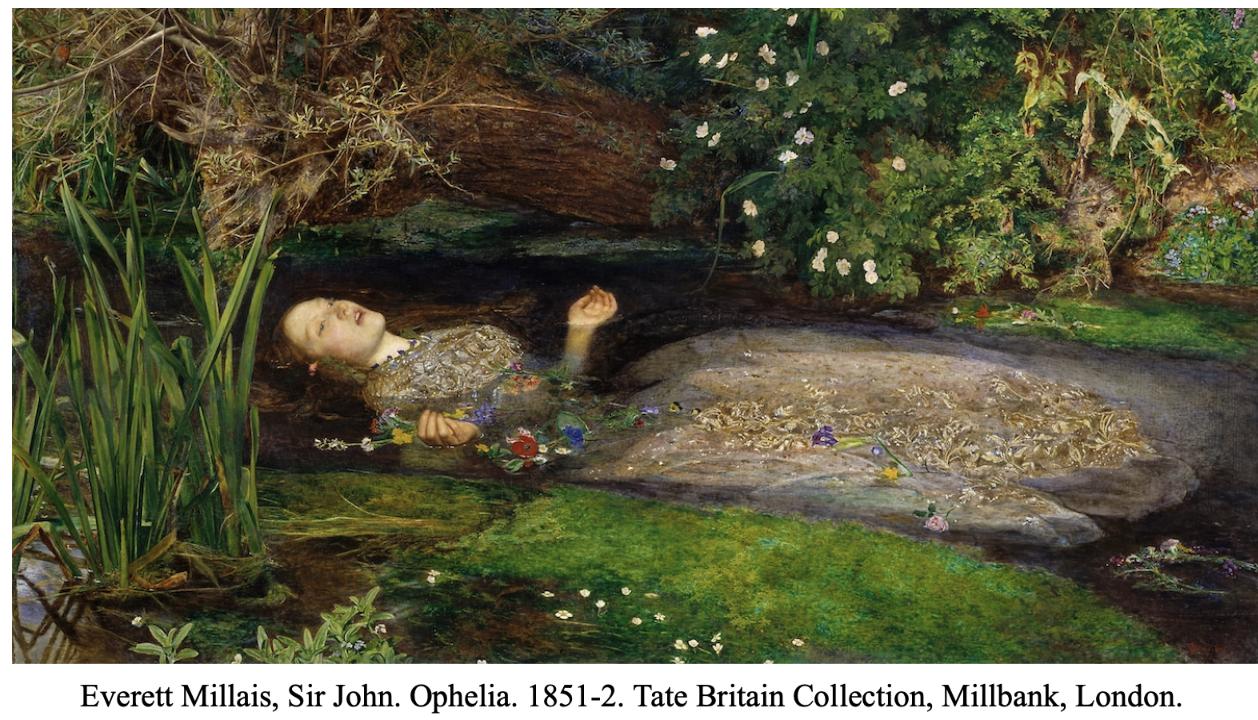Chosen one day from obscurity for her unique beauty, her red hair and porcelain skin are what made her a renowned icon of the Pre-Raphaelite movement. Elizabeth Eleanor Siddal, better known as “Lizzie” Siddal, is the model behind the well known painting titled Ophelia, by Sir John Everett Millais.
One day in the winter between the years 1849 and 1950, Walter Howell Deverell, friend of the Pre-Raphaelite Brothers, eagerly entered the art studio announcing his new discovery. “You fellows can’t tell what a stupendously beautiful creature I have found… She’s like a queen, magnificently tall.” Although she did not fit the beauty standards of the time because of her red hair and thin figure, the artists in the studio recognized her stunning visuals. After Lizzie Siddal was chosen to be a model for the Pre-Raphaelite artists, the rest would become history.
The Pre-Raphaelite Brotherhood was a secret artistic group of men formed in 1848, who aimed to revolutionize the Victorian art scene. They are recognized as the first modern art movement in Britain and are known for capturing fantasy in their realism.
Lizzie appeared in many Pre-Raphaelite artworks, but what many don’t know is that she was so much more than their model. About a month ago, a cabaret was created with the intent of depicting her life through a comedic lens, through “vivid color and song.” Many regard her life as a grim tale of toxic relationships, depression, an addiction and miscarriages. The cabaret, Look at Me Don’t Look at me, asks the viewers to reevaluate her legacy as a “tragic” historical figure.
An account published in 1899 by the son of the painter behind the Ophelia painting, John Everett Millais, revealed the grueling setting behind the scenes. He stated that in order for Millais to achieve the proper scenery, Siddal had to lie in a large bathtub for several hours, which shows her dedication towards her job.
This act of commitment brings up the conversation of whether or not suffering is needed for art to be produced. Siddal’s modeling experience is the reason why she is so heavily associated with the Shakespearean character of Ophelia, and while her role in the painting opened doors for her career, it also limited her identity to a model who suffered for an artist’s craft.
Despite having a prolific modeling career, Siddal aimed to become an artist as well after enrolling in an art school. Sometime in the spring of 1860, she married D.G. Rossetti, one of the founders of the Pre-Raphaelite movement. A lot of his drawings depict her at work in the studio, which reveal a distinct side of her that many aren’t aware of.

However, one of the most important paintings that features Siddal is the so-called “Self-Portrait” (seen above), as Siddal created it herself. In contrast to the works of male artists that portrayed her as Shakespearean heroines and Arthurian damsels, her self portrait is rather simple. Many speculate this was an artistic choice that opposed the other works she had appeared in. In her poem “The Lust of the Eyes”, Siddal describes what it is like for a woman to be loved for nothing other than her beauty, hinting at her awareness of her beauty in the eyes of the Pre-Raphealite Brothers.
The Lust of the Eyes
I care not for my Lady’s soul
Though I worship before her smile;
I care not where be my Lady’s goal
When her beauty shall lose its wile.
Low sit I down at my Lady’s feet
Gazing through her wild eyes
Smiling to think how my love will fleet
When their starlike beauty dies.
I care not if my Lady pray
To our Father which is in Heaven
But for joy my heart’s quick pulses play
For to me her love is given.
Then who shall close my Lady’s eyes
And who shall fold her hands?
Will any hearken if she cries
Up to the unknown lands?
From this, the viewers can tell that Lizzie possessed a lot of creativity, but that was unfortunately hindered by many of her life events, most notably her marriage. Her addiction to the drug laudanum and Rossetti’s unfaithfulness proved to be part of the reason behind the downfall of their relationship. Siddal experienced two miscarriages and was consumed by grief, which worsened her addiction. Her life was tragically cut short at age 32. Despite that, her efforts to become an artist during a time when women were denied access to art were moderately successful, as she was able to pursue her passion after getting married. Instead of reducing her life to a tragedy, we should remember her for her determined and bold spirit. Lizzie Siddal should be recognized as the “muse, model and painter-poet” that she was.
Bibliography:
Adams, Alexander. “Pre-Raphaelite Artists Were Actually Very Modern, Oxford Exhibition Reveals.” Whynow. 2022.
https://whynow.co.uk/read/pre-raphaelites-modern-oxford-exhibition.
Chatfield, Stephanie. “Pre-Raphaelite Marriages: Dante Gabriel Rossetti and Elizabeth Siddal.” Pre-Raphaelite Sisterhood. 10 January 2012.
http://preraphaelitesisterhood.com/pre-raphaelite-marriages-dante-gabriel-rossetti-and-elizabeth-siddal/.
“Exploring Millais’ Ophelia.” Lizzie Siddal. 4 September 2020.
http://lizziesiddal.com/portal/exploring-ophelia/.
Flood, Alison. “Elizabeth Siddall: pre-Raphaelites’ muse finally gets her own voice, 150 years after death.” The Guardian. 5 September 2018.
https://www.theguardian.com/books/2018/sep/05/real-face-of-pre-raphaelites-ophelia-to-be-revealed-elizabeth-siddall.
Hawksley, Lucinda. “The tragedy of art’s greatest supermodel.” BBC. 31 July 2020.
https://www.bbc.com/culture/article/20200103-the-tragedy-of-arts-greatest-supermodel.
Hinds, Sebastian. “Look At Me Don’t Look At Me.” Rashdash. 30 September 2022.
https://www.rashdash.co.uk/look-at-me-dont-look-at-me.
Masters, Tim. “Lizzie Siddal: Victorian model’s tragic story on stage.” BBC. 12 November 2013.
https://www.bbc.com/news/entertainment-arts-24803177.
“Miss Siddal had a trying experience…” Lizzie Siddal. 4 September 2020.
http://lizziesiddal.com/portal/ophelia/.
Moura, Natasha. “Who was Elizabeth Siddal?.” Women’n Art. 18 November 2020.
https://womennart.com/2020/11/18/who-was-elizabeth-siddal/ .
Portella, Martina. “LA TORMENTATA ESISTENZA DI LIZZIE SIDDAL, ICONA DEL MOVIMENTO PRERAFFAELLITA.” Lanterna Web. 4 April 2022.
https://www.lanternaweb.it/la-tormentata-esistenza-di-lizzie-siddal-icona-del-movimento-preraffaellita/.
“PRE-RAPHAELITE.” Tate. 30 September 2022.
https://www.tate.org.uk/art/art-terms/p/pre-raphaelite.
Renton, Catherine. “Look At Me Don’t Look At Me @ Pleasance Dome.” The Skinny. 25 August 2022.
https://www.theskinny.co.uk/festivals/edinburgh-fringe/theatre/look-at-me-dont-look-at-me-pleasance-dome.
“Sir John Everett Millais, Bt Ophelia 1851–2.” Tate. 30 September 2022.
https://www.tate.org.uk/art/artworks/millais-ophelia-n01506.
“The Faces of Elizabeth Siddal.” Lizzie Siddal. 3 September 2020.
http://lizziesiddal.com/portal/the-faces-of-elizabeth-siddal/.
Vargas, Sofía. “Conoce la fascinante historia detrás de ‘Ofelia’, la icónica pintura prerrafaelita.” My Modern Met. 3 July 2020.
https://mymodernmet.com/es/john-everett-millais-ofelia/.
Wyver, Kate. “Muse and model or painter-poet? Elizabeth Siddal given fresh portrait.” The Guardian. 7 September 2021.
https://www.theguardian.com/stage/2021/sep/07/pre-raphaelite-muse-elizabeth-siddal-rashdash-theatre.

